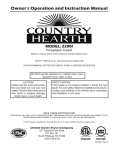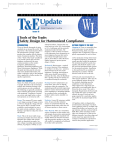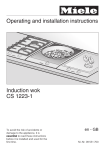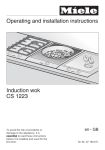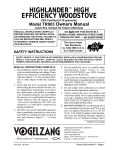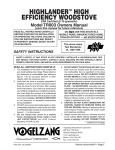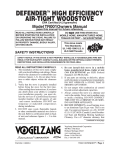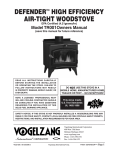Download Vogelzang International Colonial TR004 Operating instructions
Transcript
Colonial™ High Efficiency Fireplace Insert EPA Certified (4.02grams/hr) Model TR004 Owners Manual (save this manual for future reference) This appliance meets U.S. Test Standard: UL 1482-2006 Do NOT use this appliance in a mobile home, Manufactured Home, trailer, or TENT – NO EXCEPTIONS! READ ALL INSTRUCTIONS CAREFULLY BEFORE STARTING THE INSTALLATION of OR OPERATING this Appliance. Failure to follow instructions may result in property damage, bodily injury, or even death. Refer to markings on STOVE labels for additional information. Vogelzang International Corporation 400 West 17th Street Holland, Michigan 49423 www.vogelzang.com Phone: 1-616-396-1911 Fax: 1-616-396-1971 TR004M | 11102010.0 TR004 COLONIAL™ | Page 1 SAFETY INSTRUCTIONS Safety Notice: If this appliance is not properly installed a house/building fire may result. For your safety, contact local building or fire officials about permits, restrictions, and installation requirements for your area. Read All Instructions carefully. 1. The installation of this insert must comply with your local building code rulings. 2. Do not install this appliance in a mobile home, manufactured home, trailer or tent (NO EXCEPTIONS! per HUD Federal Standard: 24 CFR Ch.XX). 3. Verify that the insert is properly installed before firing the appliance for the first time. After reading these instructions, if you have any doubt about your ability to complete your installation properly, you must obtain the services of a professional licensed installer familiar with all aspects of safe and correct installation. DO NOT use temporary or makeshift compromises during installation. 4. If any parts are missing or defective, please notify the dealer or manufacturer immediately. DO NOT OPERATE An insert THAT IS MISSING ANY PARTS! 5. Warning: Risk of fire. Observe the minimum clearances to combustibles (see figures 1–3). Do not place furniture, rugs, carpet or other objects within the clearance area. 6. Warning: Risk of fire. DO NOT store wood, flammable liquids or other combustible materials within minimum clearance dimensions. Refer to certification label on unit and reference figures 1 – 3 in this manual. 7. Do not tamper with combustion air control beyond normal adjustment capacities. 8. Always connect this insert to a chimney and vent to the outside. Never vent to another room, crawlspace, or inside a building. DO NOT CONNECT THIS UNIT TO A CHIMNEY FLUE SERVING ANOTHER APPLIANCE. 9. DO NOT connect a wood burning appliance to an aluminum Type B gas vent. This is not safe. Use approved masonry or a UL 103 HT (U.S) Listed Residential Type and Building Heating Appliance Chimney. Use a 6” diameter chimney, that is high enough to give a good draft. 10. Be sure that your chimney is safely constructed and in good repair. Have the chimney inspected by the fire department or a qualified inspector. Your insurance company should be able to recommend a qualified inspector. 11. Creosote or soot may build up in the chimney liner and chimney and cause a house/building fire. Inspect the chimney liner and chimney twice monthly during the heating season and clean if necessary. Page 2 | TR004 COLONIAL™ (See Chimney Maintenance, page 12). 12. In the event of a chimney fire, turn the air control to closed position, leave the building and CALL THE FIRE DEPARTMENT IMMEDIATELY! Have a clearly understood plan on how to handle a chimney fire by contacting your local or provincial fire authority for information on proper procedures in the event of a chimney fire. 13. To prevent injury, do not allow anyone to use this appliance who is unfamiliar with the correct operation of the appliance. 14. Do not operate appliance while under the influence of drugs or alcohol. 15. For further information on using your insert safely, obtain a copy of the National Fire Protection Association (NFPA) publication, “Using Coal and Wood Stoves Safely” NFPA No. HS-101978. The address of the NFPA is Batterymarch Park, Quincy, MA 02269. 16. Ashes should not be allowed to accumulate more than an inch or two in height. Dispose of ashes in a metal container with a tight fitting lid. Keep the closed container on a noncombustible floor or on the ground, well away from all combustible materials. Keep the ashes in the closed container until all cinders have thoroughly cooled. The ashes may be buried in the ground or picked up by a refuse collector. 17. The paint used on your insert may give off smoke and/ or odor during the first fires. This may occur during the first 12 to 15 fires until the paint has cured. After the paint has cured this will end and not reoccur. Persons with lung conditions or owners of susceptible domestic pets (such as birds) should take prudent precautions. Open windows and doors as needed to clear smoke and odor. If the insert is overfired, paint discoloration will occur. 18. This inser t has a painted surface which is durable but it will not stand rough handling or abuse. When installing your insert, use care in handling. Clean with soap and warm water when insert is not hot. Do not use any acids or scouring soap, as these solvents wear and dull the finish. 19. The walls of the firebox may become slightly distorted after a period of use. A slight distortion will not affect the operation of the insert. 20. CAUTION: Hot Surfaces. Do not touch during operation. While appliance is in operation, all percontinued on next page TR004M | 11102010.0 SAFETY INSTRUCTIONS continued… sons, especially young children should be alerted to the hazards from high surface temperatures. Keep away from a hot appliance to avoid burns or clothing ignition. 21. CAUTION: Hot Surfaces. Keep children away. If small children will be in the same room as the appliance during operation, provide a sturdy barrier to keep them at a safe distance from the inser t. Never leave small children unsupervised when they are in the same room as the appliance. 22. Keep area around the appliance clear and free from all combustible materials, gasoline, and other flammable vapors and liquids. 23. To prevent bur ns always wear protective clothing, leather hear th gloves and eye protection. 24. Warning: Risk of fire. While in operation, keep the feed door closed and secured at all times except while tending the fire. 25. Do not over fire the inser t. Over firing will occur if the feed door is left open during operation. Such actions can result in very dangerous operating conditions. 26. DO NOT ELEVATE FIRE! Build fire directly on the bottom of the firebox. This appliance has not been tested with the use of grates, andirons, or other means of elevating fire and should not be used. 27. All power cords and electrical appliances and/or assemblies must be kept outside of the clearance dimensions shown in this manual for combustible materials. TR004M | 11102010.0 NOTE: A professional, licensed heating and cooling contractor should be consulted if you have questions regarding the installation of this solid fuel burning appliance. TR004 COLONIAL™ | Page 3 Table of Contents Safety Precautions......................................................................................... 2 – 3 Product Dimensions............................................................................................ 5 Pre-installation Requirements............................................................................ 6 Chimney Condition ..................................................................................... 6 Minimum Clearances to Combustible Materials ....................................... 6 Venting ......................................................................................................... 7 Floor Protector ............................................................................................ 7 Tools and Materials Required for Installation.................................................... 8 Assembly Instructions Chimney Connection . ................................................. 8 Chimney Connection ................................................................................ 9 Faceplate Assembly . ................................................................................ 9 Firebrick Assembly ................................................................................... 9 Chimney Connections/Draft.............................................................................. 10 Operating Instructions House Fire Hazards, Operating Precautions, Warnings....................... 11 Wood Types/Sizes..................................................................................... 11 Optimal Fuel Consumption..................................................................... 11 Starting a Fire, Adding Fuel.................................................................... 12 Blower Operation.................................................................................... 13 Service Hints Creosote Formation, Prevention, Removal . ......................................... 13 Chimney Draft ......................................................................................... 13 Glass Care & Replacement, Glass Gasket Replacement .................... 14 Parts – Colonial™ ............................................................................................. 15 Parts – Glass Door (Glass Replacement)........................................................ 16 F-5 Blower Wiring Diagram................................................................................ 16 Floor Protector Calculations............................................................................. 17 Page 4 | TR004 COLONIAL™ TR004M | 11102010.0 Colonial™ dimensions TR004M | 11102010.0 TR004 COLONIAL™ | Page 5 Pre-Installation Requirements Fireplace condition & Zero Clearance Requirements A masonry fireplace must meet minimum code requirements, National Fire Protection Association, (NFPA) 211, or the equivalent for a safe installation. Contact a professional, licensed installer, your local building inspector or the local fire authority for the requirements in your area. Your insurance company should be able to recommend a quallified inspector. Inspections should include the following: 1. Condition of the fireplace and chimney. A masonry fireplace and chimney MUST be inspected prior to installation of this insert. They must be free from cracks, loose mortar, creosote deposits, blockage or other evidence of deterioration. If found, these items MUST be repaired prior to installation. DO NOT REMOVE BRICKS or MORTAR from existing fireplace when installing this unit. 2. Chimney Size. Minimum chimney size is 6˝ (152mm) diameter. Maintain a 15 ft. minimum overall chimney height measured from the top of appliance to the top of the chimney. Chimneys must extend at least 3 ft. above the roof and at least 2 ft. above the highest point within 10 ft. of the chimney top. See the Chimney Connections section of this manual. 2. Zero Clearance or Metal Heatform Fireplaces. These fireplaces and chimneys must meet the minimum code specifications as noted above. Factory built zero clearance fireplaces must be listed and suitable for solid fuel use. Chimneys must be at least 7 inch diameter to accomodate a required, continuous, stainless steel liner from the insert flue collar to the top termination of the chimney. Only detachable parts that can be easily replaced (i.e. damper parts, screens, doors and side and back refractory panels) are to be removed. These parts must be stored and readily available for replacement if the insert is ever removed. The removal of any parts that render the fireplace unusable for burning solid fuel requires a permanent label to be affixed by the installer that states the fireplace is unsuitable for burning solid fuel unless the missing parts are replaced and the fireplace is restored to its original, certified condition. 3. Chimney Caps. Mesh type chimney caps and spark arrestors must be able to be removed for regular inspection and cleaning. Otherwise the mesh should be removed to prevent possible plugging. Check your local fire and building codes. 4. Chimney Liner. The chimney must be suitable for burning solid fuel. Install a continuous stainless steel liner from the flue collar of the appliance to the top of the chimney. Liner must be UL Listed to UL1777. Page 6 | TR004 COLONIAL™ 5. Fireplace Opening Dimensions. A. Minimum Height...........23˝ B. Minimum Widths...........29˝ C. Minimum Depth............14˝ Figure 1 Minimum Opening Specifications 6. Combustible Material Clearances. The fireplace and chimney must be inspected to make sure there is adequate clearance to combustible materials. This includes the top, side, front and back as well as concealed combustibles in the chimney and mantle areas. Your local building inspector or fire authority should have information on whether older fireplace meet current codes and are suitable for use. See also figure 1 and figure 2. D. Min. Distance to Sidewall.........12˝ E. Min. Distance to Top Trim.........15˝ F. Min. Distance to Mantle...........21.75˝ G. Min. Distance to Side Trim.......9.5˝ H. Min. Floor Protector Front........24˝ I. Min. Floor Protector Side.........6˝ Figure 2 Minimum Clearance to Combustible Materials 7. Makeup Air Requirements. This insert requires an adequate supply of makeup air to operate safely and efficiently. In some areas, this is a building code requirement. Inadequate air supply will cause poor combustion, inefficient operation, creosote buildup, back drafting and smoke puffing into the living areas. If any of the following conditions are evident, a makeup air supply MUST be installed. TR004M | 11102010.0 a. Existing fuel-fired equipment show evidence of back puffing, smoke roll-out, inefficient operation or excessive smell in the living area. b. Opening a window or door alleviates any of the above problems or symptoms. c. The building is constructed with a well-sealed vapor barrier, tight fitting windows or has powered exhaust fans. d. Excessive condensation on windows in the winter. e. The building has a ventilation system installed. f. If, once installed, the solid-fuel appliance does not draw steadily, burns poorly or inefficiently, back-drafts or experiences back-puffing when adding fuel. Venting (Draft) Requirements The chimney flue is a critical component to the proper and efficient operation of any heating appliance. Heating appliances do not create draft, draft is provided by the chimney. This appliance requires a draft of 0.05 in. water column (0.1 Pa) at the flue collar. Warning: Risk of Fire - Excessive draft can cause over firing and possible structure fire. Do not operate appliance with flue draft exceeding 0.06 in. w.c. (0.1 Pa). To achieve proper draft, your chimney must meet three minimum height requirements; minimum height from top of appliance (15 ft. total height from top of appliance), minimum height above roof penetration (3 ft.), and minimum height (2 ft.) above highest point of roof within a 10 ft. diameter from the chimney. See Chimney Connections section of this manual. The chimney must also meet minimum and maximum cross sectional requirements. For that reason a continuous 6˝ stainless steel liner from the flue collar to the top of the chimney is required. A stainless steel adapter is recommended for fastening the stainless steel liner to the flue collar. The male (or crimped) end of the adapter must be installed inside the flue collar to allow condensation or creosote in the liner to drain back into the firebox. Chimney liners and/or adapters must be permanently fastened using a minimum of three (3) screws at each connection. Chimneys outside of the home or on an exterior wall are difficult to keep at operating temperatures and may result in increased creosote buildup, less draft, back drafting problems and poor appliance performance and should be avoided. Floor Protector A solid non-combustible floor, concrete or solid masonry must extend 6˝ to either side of the body of the insert and 24˝ in front of the face of the insert. This would require a floor protector 38˝ wide by 24˝ deep. (See figures 2 & 3) When combustible flooring falls within these minimum dimensions, it must be covered with a listed floor protector such as Hy-C or Imperial Model UL 2840BK or equivalant with 0.84 R-factor. (Note: to calculate R-value of alternative materials see Floor Protector Material Calculations at the back of this manual.) A grouted ceramic floor tile that meets local building codes and the minimum 0.84 R-factor requirements is considered a durable equivalent. Warning: Risk of Fire. Do not allow combustible materials (carpet, furniture, fuels) to be placed on or cover the floor protector. All combustible materials must remain outside of the minimum clearance dimensions. Figure 3 Floor Protector Specifications TR004M | 11102010.0 TR004 COLONIAL™ | Page 7 Assembly Instructions NOTICE: Vogelzang International Corp. grants no warranty, stated or implied, for the installation or maintenance of your wood stove and assumes no responsibility of any incidental or consequential damages. Tools and Materials Required for Installation • • • • • • • • • tools Pencil 6 foot Folding Rule or Tape Measure Tin Snips Drill: Hand or Electric 1/8” dia. Drill Bit (for sheet metal screws) Screwdrivers (blade and Phillips type) 14mm Nut Driver or Ratchet with 14mm Socket Safety Glasses Gloves materials (NOTE: The following items are not included with your stove) Flooring Protection: 24” x 38” as specified (see page 5) Chimney Liner: Continuous stainless steel chimney liner (as required) Stainless Steel Adapter (connects the liner to the flue collar) 1/2” Sheet Metal Screws Furnace Cement (manufacturer recommends Rutland Code 78 or equivalent) CAUTION: INSERT is heavy. Make sure you have adequate help and use proper lifting techniques whenever moving the insert. 1. Clean the fireplace opening properly disposing of any ashes in a closed metal container. See Safety Instructions, #16 on page 2. 2. Install a 6˝ (152mm) minimum diameter, continuous stainless steel chimney liner into the existing chimney. The liner must extend to the top of the existing chimney. Use only listed chimney liners that meet UL1777 standards. Follow liner manufacturer installation instructions. 3. Remove or lock the fireplace damper in the open position. Note: Masonry or damper plate may be removed to accomodate the chimney liner provided this does not weaken any structural components of the existing fireplace or chimney nor reduces protection of combustible materials required by national building codes. Consult with your local building or fire authority before doing this. 4. Uncrate the insert, remove all packing materials, and any items stored in the firebox. 5. WARNING: Any fireplace which has had parts removed or modified to accomodate the installation of this insert MUST have a warning plate permanently installed in a visible location stating that the fireplace is unfit for use with solid fuel. Permanently attach the warning plate to a visible location in the fireplace. 6. Position the insert into the fireplace opening until the top lip of the air jacket is flush with the fireplace facing. 7. Direct power cord of blower to desired side of insert and attach blower to front of unit using two screws. 8. Level the insert with the adjusting screws at the rear of the appliance. Page 8 | TR004 COLONIAL™ Fig. 4– Stainless Steel Liner Connection 9. Connect the chimney liner to the insert using a stainless steel adapter and securing with a minimum of three (3) sheet metal screws. The liner MUST be attached with the male (or crimped) end of the adapter inside the flue collar of the insert to allow condensation and/or creosote to drain back into the firebox. 10. Assemble the face plate (figure 5). Lay pieces face down on carpet or other soft surface to protect finish during assembly. The face plate consists of two side Continued on next page TR004M | 11102010.0 panels, a top panel and a decorative trim frame. 11. Bolt the top panel (1) to the side panels (2) so the top surfaces are flush to one another. 12. Assemble the trim frame. The trim consists of a left (7) and right (4) side piece and a split top piece (left #6, right #5). These are joined by two corner connectors (8) and a straight center connector (9). These slide into the channel on the back of the frame and are secured with two set screws (10) in each piece. 15. The faceplate assembly is held in place with two springs at the top of either corner of the insert (figure 6). 16. Connect power cord of blower to grounded receptacle. 17. Firebrick extends the life of your stove and radiates heat more evenly. If firebricks were removed to position insert replace them before firing insert. See figure 7 for proper orientation and positioning. Install the back row first, then sides and finally install bottom firebricks. CAUTION: RISK of Fire. • REPLACE FIREBRICKS Before firing woodstove. Position firebricks so no gaps remain between bricks. • Never operate appliance with missing or cracked fire bricks. • Keep furnishings and other combustible materials away from the stove AND OUTSIDE Minimum Clearances. Figure 5 – Face Plate Assembly A A A A A Fire Brick Dimensions A-Size: 9˝ x 41/2˝ M-Size: 9˝ x 21/4˝ R-Size: 9˝ x 33/8˝ S-Size: 11/4˝ x 21/4˝ T-Size: 9˝ x 31/3˝ Five (5) A-Size Note: All fire brick are 11/4˝ thick Figure 7a – Step 1, Back Firebrick Arrangement Six (6) T-Size T TR004M | 11102010.0 A T M A A T T R T A A S A A T Figure 7b– Step 2, Side Firebrick Arrangement T T A Figure 6 – Face Plate Installation T A A T A A A T A R 13. The trim slides over the face panel assembly and is secured at the base of each side with a machine screw (11). 14. The Faceplate Assembly is then slid over the insert. Slots in the two side panels accomodate the hood at the top of the insert (figure 6). T Four (4) A-Size One (1) M-Size Two (2) R-Size One (1) S-Size Figure 7c– Step 3, Bottom Firebrick Arrangement TR004 COLONIAL™ | Page 9 Chimney Specifications This appliance must be connected to a listed Stainless Steel Liner, that meets UL1777, which extends from the collar to the chimney cap according to the specifications listed on the previous pages. Chimneys perform two functions: 1). As a means of exhausting smoke and flue gases which are the result of fuel combustion. 2). The chimney provides “draft,” which allows oxygen to be continuously introduced into the appliance, so that proper combustion is possible. This stove relies on natural draft to operate. NOTICE: Always provide a source of fresh air into the room where the stove is located. Failure to do so may result in air starvation of other fuel burning appliances and the possible development of hazardous conditions, fire or death. Your insert itself does not create draft. Draft is provided by the chimney. To achieve proper draft your chimney must meet the three minimum height requirements detailed in figure 8. A minimum draft of 0.05 w.c. (measured in water column) is required for proper drafting to prevent back puffing, smoke spillage, and to maximize performance. (Gauges to measure draft are readily available at stove stores and are economical to rent or purchase.) Factors such as wind, barometric pressure, trees, terrain and chimney temperature can have an adverse effect on the draft. The manufacturer cannot be held responsible for external factors leading to less than optimal drafting. Should you have a problem with inadequate draft, you should contact a licensed heating and cooling contractor for assistance in solving the problem. IMPORTANT Installation Points 1. Size chimney flue to appliance collar. This stove requires a minimum 6” diameter flue. 2. Never connect this unit to a chimney serving another appliance. 3. The chimney must meet all minimum height requirements. 4. Never use a chimney to ventilate a cellar or basement. 5. C o n t a c t y o u r l o c a l b u i l d i n g a u t h o r i t y for approved methods of installation and any necessary permits and/or inspections. to a masonry chimney are detailed in the installation instructions. If the fireplace chimney must go through a combustible wall before entering the main chimney, consult a qualified mason or chimney dealer regarding proper materials that meet all local building and fire authourity codes. The installation must conform to local building and fire codes and latest edition of NFPA 211. If there is a cleanout opening in the base of the chimney, close it tightly. Figure 8 - Chimney Construction Masonry Chimney Before using an existing masonry chimney, clean the chimney, inspect the flue liner and make any repairs needed to be sure it is safe to use. As mentioned previously, this appliance requires a continuous stainless steel liner from the insert collar to the chimney cap. Make repairs before attaching the stove. The connector stove pipe and fittings you will need to connect directly Page 10 | TR004 COLONIAL™ TR004M | 11102010.0 Operating Instructions CAUTION: HOUSE FIRE HAZARDS This appliance is designed to burn WOOD FUEL ONLY! • Do not store wood on floor protector, underneath stovepipe(s) if applicable, or anywhere within minimum clearances from combustible surfaces specified for this appliance. Hardwood, 17” to 19”, should be split and air dried (seasoned) for 6 months to obtain maximum burning efficiency. Wood should be stored in a dry, well ventilated area. •Overfiring may cause a house fire. You are overfiring If a unit glows Red. NOTICE: Use solid wood materials only. Do Not burn garbage or flammable fluids. Do Not Use Coal. This INSERT is not designed to accommodate the air flow (draft) necessary to properly burn coal or coal products. Do not elevate fire or use grates or andirons. Build fire directly on bottom of firebox. Operating Safety Precautions 1. Never overfire this appliance by building excessively hot fires as a house/building fire may result. You are overfiring the appliance if it begins to glow or turn red. 2. Never build extremely large fires in this type of applianace as damage to the firebox or smoke leakage may result 3. Do not build fire too close to glass. 4. Unit is HOT while in operation. Keep children, clothing, and Furniture away. Contact may cause skin burns. Do not touch the appliance after firing until it has cooled. 5.Provide air into the room for proper combustion. 6. Inspect chimney liner every 60 days. Replace immediately if liner is rusting or leaking smoke into the room. WARNING: Explosion Hazard • Never use chemicals, gasoline, gasoline-type lantern fuel, kerosene, charcoal lighter fluid, or similar flammable liquids to start or “freshen-up” a fire in the stove. • K eep all flammable li q u ids , especially gasoline, out of the vicinity of the stove— whether in use or in storage. OPTIMAL FUEL CONSUMPTION This insert is designed to get the most efficient transfer of heat energy from the wood fuel and radiate it into your living environment. The fire box introduces combustion air through three sources; (1) Immediately beneath the door opening below the window is a Lower Primary Air Orifice (LPAO), (2) The door air inlet control brings air into the firebox and controls the rate of burn (and the amount of heat the insert radiates), (3) The secondary air tubes at the top of the firebox are designed to ignite the combustion gases (smoke) given off by the burning wood and increases the efficiency of the insert and reduces chimney emissions. Smoke given off by burning fuel consists of very small organic liquid droplets. If these droplets condense, they form a sticky tar-like substance called creosote. When operated properly, this insert is designed to burn these droplets. Burning these droplets releases heat that would otherwise be lost up the chimney as smoke. Following the instructions below will help you operate your insert properly to maximize the insert’s performance. Actual performance is dependent on chimney height, weather, log size, wood species and moisture content. Some experimentation will initially be required to find that “sweet spot” where your insert performs best. The following will give you a starting point to find your optimum settings. When first loading fuel, set the door air inlet control at the wide open position for at least 15–20 minutes. When the insert is working properly you should be able to observe secondary combustion flames above the fuel pieces in front of the secondary air tubes at the top of the firebox. These secondary flames should continue to burn after the primary air inlet is reset from wide open to the desired operating setting. If the flames do not continue to burn, open the air control to re-establish the Continued on next page TR004M | 11102010.0 TR004 COLONIAL™ | Page 11 Operating Instructions continued . . . secondary flames then slowly reset the air control to the desired setting. Initially it may take several attempts to figure your insert out. But once you find the operating “sweet spot” and the correct mix of procedures to get there, only minor adjustments will be necessary. The best indicator of a properly operating insert is to look for smoke coming out of the chimney. You may see steam emissions that will quickly dissipate. Smoke will thin but continue to drift without totally disappearing. If you do detect smoke emissions, open the air control a little bit, let the insert adjust for 10–15 minutes and re-check your chimney. Remember – visible smoke represents lost heat. NOTICE - INITIAL BURNS to Cure PAINT. Because of the high operating temperatures, this insert uses a special high-temp paint which requires a series of burns to cure the paint for durability and a lifetime of service. Proper curing of the high-temp paint requires a series of three initial burns. The insert should be allowed to cool off between each burn. The first two burns should be small fires and low temperatures (250 degrees F) for a duration of 20 minutes each. The third fire should be at a medium-high temperature (500 F to 700 F) for 20 minutes. Provide adequate cross ventilation to clear any smoke or odor caused by initial firings. STARTING a Fire 1. Set air inlet control to fully open position. 2. Open the door and place several wads of crushed paper in the firebox. 3. Cover the paper with a generous amount of kindling in a teepee fashion and a few small pieces of wood. 4. Ignite the paper and leave the door open slightly. DO NOT LEAVE Insert UNATTENDED WITH DOOR OPEN! 5. Add large pieces of wood as the fire progresses being careful not to overload. (Do not fill firebox beyond firebrick area.) An ideal coal bed of 1 – 2” should be established to achieve optimum performance. 6. This unit is designed to function most effectively when air is allowed to circulate to all areas of the firebox. TIP: If ash or coals remain in the insert, make sure to clear them away from the Lower Primary Air Orifice (LPAO) and rake a slight (1-to-2 inch wide) trough down the center of the coal bed from front to back prior to loading the fuel. Page 12 | TR004 COLONIAL™ 7. Once fuel has been loaded, close the door and leave the air inlet control fully open until fire is well established (at least 15–20 minutes) being careful not to over fire (if any of the exterior parts of the insert or chimney connections begin to glow you are over firing the insert). 8. Re-adjust the door air inlet control to desired burn rate. (If excessive smoke fills the firebox, open air inlet control slightly until flames resume and wood is sufficiently ignited.) The basic rule of thumb is “closed - low,” “half way open - medium” and “fully open - high.” Adding Fuel If the coal bed is not hot and glowing, rake the coals to the front of the insert, close the door and adjust the air inlet control to the wide open position. Let the coals reheat for 10–15 minutes. When hot and glowing, spread them out and place your next fuel load into the insert (make sure no coals or ashes block the LPAO). Leave the door air inlet control in the wide open position for 15–20 minutes. Fuel load size can vary but should be kept 1–2 inches below the secondary air tubes. Also position the fuel to leave space so the air from the inlet can work down between the pieces of fuel. This reduces the time it takes for new fuel to burn properly. 1. When refueling, adjust air inlet control to the fully open position. When fire brightens, slowly and carefully open the door. This procedure will prevent gases from igniting causing smoke and flame spillage. 2. Add fuel being careful not to overload or overfire the insert. 3. When adding fuel be careful not to smother the fire. Do not build fires against glass and make sure the coal bed does not obstruct the air inlet. 4. Close the feed door and secure tightly. 5. Adjust the air inlet control as described above. 6. Empty ashes regularly. Do not allow ashes to pile up (see Safety Instructions #16 on page 2.) 7. Properly dispose of hot ashes (see Safety Instructions, item #16 on page 2.) 8. Do not overfire the insert (overfiring is when any par t of the inser t exterior or chimney connections glow). CAUTION: DO NOT OVERFIRE appliance. You are overfiring if any part of the insert glows red. Close the door and shut damper immediately to reduce the air supply and slow down the fire. TR004M | 11102010.0 Operating continued . . . Chimney Maintenance Blower Operation The variable speed blower circulates air warmed by the firebox into the living area to distribute the heat more evenly. The blower control knob is located on the side of the blower housing. Turn the knob clockwise to turn the blower on. The speed is controlled by turning the knob clockwise for slower speeds and counter-clockwise for faster speeds. To turn the blower off, turn the speed control knob fully counter-clockwise. It is recommended to turn the blower off when the unit is not in operation. Chimney Maintenance CAUTION: Slow burning fires and extended use m ay cause exces sive creosote buildup. Ignition of creosote or over firing may cause A chimney fire. Chimney fires burn extremely hot and may ignite surrounding materials. In case of a chimney fire call the fire department immediately. CREOSOTE – Formation and Removal When wood is burned slowly, it produces tar and other organic vapors which combine with expelled moisture to form creosote. The creosote vapors condense in the relatively cool chimney flue of a slow-burning fire and can accumulate on the flue lining. If ignited, this creates an extremely hot fire in the chimney which may ignite surrounding materials resulting in a building fire. The chimney connector and chimney should be inspected (at least) twice a month during the heating season to determine if a creosote buildup has occurred. If it has, it should be removed. Failure to remove creosote may result in ignition and may cause a house/building fire. Creosote may be removed using a chimney brush or other commonly available materials from your local hardware retailer. Chimney fires burn very hot. If the unit or chimney connector should glow red, reduce the fire by closing the inlet air control and immediately call the fire department. CAUTION: A chimney fire may cause ignition of wall studs or rafters which were assumed to be a safe distance from the chimney. If a chimney fire has occurred, have your chimney inspected by a qualified Expert before using again. A fire in the firebox may be smothered by pouring a large quantity of coarse salt, baking soda, or cool ashes on top of the fire. TR004M | 11102010.0 Preventing Creosote Buildup 1. Burn with air control open for several minutes at numerous intervals throughout the day during the heating season, being careful not to overfire the unit. 2. Burn insert with air inlet control wide open for 15–20 minutes every time you apply fresh wood. This allows wood to achieve the charcoal stage faster and burns wood vapors which might otherwise be deposited within the heating system. 3. BURN ONLY SEASONED WOOD. Avoid burning wet or green wood. Seasoned wood has been dried for at least one year. 4. A small hot fire is preferable to a large smoldering one that can deposit creosote within the heating system. 5. Establish a routine for the handling of fuel, wood burner and firing technique. Check daily for creosote buildup until experience shows how often you need to clean for safe operation. Be aware that the hotter the fire, the less creosote is deposited, and weekly cleanings may be necessary in mild weather even though monthly cleanings may be enough in colder months. WARNING: In case of chimney fire; (1) Close air inlet control, (2) Get out of the house, (3) Call the fire department. Chimney Draft NOTE: A draft reading of 0.05 to 0.06 w.c. (water column) is required for proper burning of this insert. Draft is a function of the chimney, not the insert — do not expect the insert to draw. Smoke spillage into the house or excess buildup of condensation or creosote in the chimney are warnings that the chimney is NOT functioning properly. Correct the problem before using the insert. Following are some possible causes for improper draft. 1. The connector insert pipe may be pushed into the chimney too far, stopping the draft. 2. If the chimney is operating too cool, water will condense in the chimney and run back into the insert. Creosote formation will be rapid and may block the chimney. Operate the insert at a fire level high enough to keep the chimney warm preventing this condensation. 3. If the fire burns well but sometimes creates excessive smoke or burns slowly, it may be caused by the chimney top being lower than another part of the house or a nearby tree. The wind blowing over a Continued on next page TR004 COLONIAL™ | Page 13 Service Hints house or tree falls on top of the chimney like water over a dam, beating down the smoke. The top of the chimney should be at least three (3) feet above the roof and be at least two (2) feet higher than any point of the roof within ten (10) feet. Glass Care The following usage and safety tips should be observed: 1. Inspect the glass regularly for cracks and breaks. If you detect a crack or break, extinguish the fire immediately and contact the manufacturer for a replacement. 2. Do not slam the door or otherwise impact the glass. When closing doors, make sure that logs or other objects do not protrude to impact the glass. 3. Do not build fires against (or that might fall against) the glass. 4. Do not clean the glass with materials that may scratch (or otherwise damage) the glass. Scratches on the glass can develop into cracks or breaks during operation. 5. Never attempt to clean the glass while the unit is hot. If deposits are not very heavy, normal glass cleaners are adequate using a soft, non-abrasive cleaning pad. Heavier deposits may be removed with oven cleaners. 6. Never put substances which can ignite explosively in the unit. Even small explosions in confined areas can blow out the glass. 6. Trim to length and butt ends together. 7. Replace glass into door, being sure not to overtighten screw and clip. After extensive use, the gasket material which provides glass and door seal may lose it’s resiliency and will need to be replaced. Inspect glass and door gaskets periodically to ensure proper seal; if gaskets become frayed or worn, replace immediately. Door Gasket Replacement Procedure: 1. Ensure appliance is not in operation and is thoroughly cooled. 2. Remove old door gasket and clean channel. 3. Using an approved, high temperature gasket cement, apply a thin coat in bottom of channel. 4. Starting at hinge side of door, work gasket into channel around door unit, end butt and trim to length. 5. Close door and allow three to four hours for cement to set before firing appliance. Gasket and Glass cleaning products are available at local retail home centers. Manufacturers of cleaning products for wood stoves include, A.W. Perkins Co. (www.awperkins.com) or Rutland Products (www. rutland.com). Glass Replacement Caution: Replace glass ONLY with 5mm High Temperature ceramic glass of the proper size. Do not use tempered glass or double thickness window glass! Glass Replacement Procedure: 1. Ensure appliance is not in operation and is thoroughly cooled. 2. Remove screw and glass clip. (See parts list and diagram.) 3. Lift glass out from glass clip. 4. Remove old gasket and clean glass. 5. Replace new gasket starting at the bottom of glass working along edges, being sure to center gasket channel on glass. Page 14 | TR004 COLONIAL™ TR004M | 11102010.0 Parts - TR004 Colonian High-Efficiency Insert When ordering missing or replacement parts, always give the Model Number of the insert, Part Number, and Part Description. Use the illustrations and part lists provided to identify parts. Contact us at 616-396-1911 to order parts. Ref. No. Qty. 01 02 03 04 05 06 07 08 09 10 11 12 13 – – – – – 14 15 16 17 18 19 20 21 22 23 34 TR004M | 11102010.0 Part No. Dscription 04-01 04-02 04-03 F-5 SC-01 04-06 04-07 04-08 04-09 04-10 04-11 04-12 04-13 A M R S T 04-14 04-15 04-16 04-17 04-18 04-19 04-20 04-21 04-22 04-23 HP-04 Draft Control Lever.................. 1 Screw, Rear Leveling Adj........ 2 Intake Vent Cover.................... 1 Blower..................................... 1 Variable Speed Control........... 1 Air Tube, Front......................... 1 Air Tube, Middle...................... 1 Air Tube, Rear......................... 1 Retainer Clip, Air Tubes.......... 3 Screw, Retainer Clip............... 3 Fiberboard Baffle, Front.......... 1 Fiberboard Baffle, Rear........... 1 Fiber Blanket........................... 1 Fire Brick 9˝x 4 ¹⁄2˝................... 5 Fire Brick 9˝x 2 ¹⁄4˝................... 1 Fire Brick 9˝x 3 ³⁄8˝................... 2 Fire Brick 1¹⁄4˝x 2 ¹⁄4˝................ 1 Fire Brick 9˝x 3 ¹⁄3˝................... 6 Face Plate, Side...................... 2 Face Plate, Top....................... 2 Trim, Left Side......................... 1 Trim, Right Side....................... 1 Right Trim, Top........................ 1 Left Trim, Top........................... 1 Corner Bracket........................ 2 Center Bracket........................ 1 Screw, Trim Brackets............... 6 Spring..................................... 2 Hardware Pack........................ 1 parts list continued on next page TR004 COLONIAL™ | Page 15 Parts - TR004 Colonial High-Efficiency Insert When ordering missing or replacement parts, always give the Model Number of the insert, Part Number, and Part Description. Use the illustrations and part lists provided to identify parts. Contact us at 616-396-1911 to order parts. 33 30 31 24, 25, 26 27 28 29 32 Ref. No. 24 25 26 27 28 29 30 31 32 33 Part No. DescriptionQty. 04-24 Door Assembly (complete)..................... 1 04-25 Handle Assembly (complete).............. 1 04-26 Door Frame (only)............................... 1 04-27 Door Glass.......................................... 1 WG01 Gasket, 7/8˝ Fiberglass Glass............. 1 04-29 Retainer, Glass.................................... 5 04-30 Screws, Glass Retainer....................... 8 04-31 Retainer, Glass, Handle Side.............. 1 GK34 Gasket, Door....................................... 1 04-33 Hinge Pin............................................. 2 Wiring Diagram - Colonial F-5 Blower Page 16 | TR004 COLONIAL™ TR004M | 11102010.0 Floor Protector Material Calculations This stove has been tested for and must be installed on a floor protector with the proper Thermal Resistance or R-value as stated in the installation instructions on page 3, “Locating Stove” step 1, of this manual. If the floor protector materials listed in the instructions are not available, materials with an equivalent R-value may be substituted. Alternate materials may be rated with C-factor (Thermal Conductance) or k-factor (Thermal Conductivity) ratings which must be converted to R-value to determine if the alternate material meets the tested requirements. The following instructions provide the proper information and formulas for conversion to R-value. To determine if alternate materials are acceptable follow this sequence. 1. Convert material specifications to R-value: a. R-value given — no conversion necessary b. k-factor is given with a required thickness (T) in inches: R = 1/k x T c. C-factor is given: R = 1/C 2. Determine the R-value of proposed alternate floor protector: a. Use formulas in step 1 above to calculate R-value of proposed material(s). b. For multiple layers, add R-values of each layer to determine overall R-value. 3. If the overall R-value of the floor protector system is equal to or greater than the floor protector specifications given, the alternate is acceptable. Definitions: Thermal conductance (C) = BTU = 2 (hr)(ft )(°F) W (m )(°K) Thermal conductivity (k) = (Btu)(inch) = (hr)(ft2)(°F) W = (m)(°K) Thermal resistance (R) = (ft2)(hr)(°F) = Btu (m2)(°K) W 2 Example: The specs of floor protector material should be 3/4-inch thick material with a k-factor of 0.84. The proposed alternative material is 4” brick with a C-factor of 1.25 over 1/8-inch mineral board with a k-factor of 0.29. Step 1: Convert specs to R-value. R = 1/k x T = 1/0.84 x 0.75 = 0.893 System must have a R-value of 0.893 = Rspecs Step 2: Calculate R-value of individual components 4” Brick with C-factor = 1.25. R = 1/C = 1/1.25 = 0.80 = Rbrick 1/8-inch (0.125”) mineral board with k-factor = 0.29. R = 1/0.29 x 0.125 = 0.431 = Rmin.brd. Step 3: Add R-values of components to get total R-value of system Rbrick + Rmin.brd = 0.80 + 0.431 = 1.231 = Rsystem Step 4: Compare Rsystem to Rspecs Rsystem = 1.231 is larger than Rspecs of 0.893. System R-value exceeds specifications and therefore is an acceptable alternative. TR004M | 11102010.0 Btu (hr)(ft)(°F) the required TR004 COLONIAL™ | Page 17 This Vogelzang heating appliance is safe when installed properly and will provide you with years of service. However, always exercise good judgement when you are using this stove. You are dealing with FIRE! Fire is inherently dangerous and must be treated with respect. Stay warm and in good health! Respectfully yours, Steve Vogelzang Proprietor Company Testimony: “For God so loved the world that he gave his only begotten Son, that whoever believes in Him shall not perish but have eternal life” John 3:16 MADE IN CHINA Vogelzang International Corporation 400 West 17th Street Holland, Michigan 49423 www.vogelzang.com Phone: 1-616-396-1911 Fax: 1-616-396-1971 Page 18 | TR004 COLONIAL™ TR004M | 11102010.0


















